1994 CHEVROLET SUBURBAN clutch
[x] Cancel search: clutchPage 69 of 385

Automatic Transmission:
Move your shift lever to “P’ (Park) or “N” (Neutral). Your engine won’t
start in any other position
- that’s a safety feature. To restart when you’re
already moving, use
“N’ (Neutral) only.
NOTICE:
Don’t try to shift to “P” (Park) if your vehicle is moving. If you
do, you could damage the transmission. Shift to “P” (Park) \
only
when your vehicle is stopped.
Manual Transmission:
Hold the clutch pedal to the floor, then shift your gear selector to neutral
while starting the engine. Your vehicle won’t start if the clutch pedal is not
all the way down
- that’s a safety feature.
To start your 5.7 Liter (Code K) or 7.4 Liter (Code N) V8 engine:
1. Without pushing the accelerator pedal, turn your ignition key to
START. When the engine starts, let go of the key. The idle speed will
go down
as your engine gets warm.
NOTICE:
Holding your key in “Start” for longer than 15 seconds at a time
will cause your battery to be drained much sooner. And the
excessive heat can damage your starter motor.
2. If it doesn’t start right away, hold your key in START. If it doesn’t start
in three seconds, push
the accelerator pedal about one-quarter of the
way down for
12 more seconds, or until it starts.
flooded with too much gasoline. Try this:
3. If your engine still won’t start (or starts but then stops), it could be
Wait
15 seconds to let the starter motor cool down. Then push your
accelerator pedal all the way to
the floor. Hold it there. Then hold the
key in “Start” for
no more than ten seconds. This clears the extra
gasoline from the engine. If the engine still doesn’t start, wait another
15 seconds and do Step 3 again.
Hot Engine Restart (Vehicles With 5.7L LO5 Engine and Over 8500 lbs.
GVWR): If your engine is already hot and then stalls, turn your ignition
key to
OFF. Then, turn your key to ON, and wait about 20 seconds
before you restart your engine.
When the engine starts,
let go of the key and the accelerator pedal.
2- 14
ProCarManuals.com
Page 71 of 385
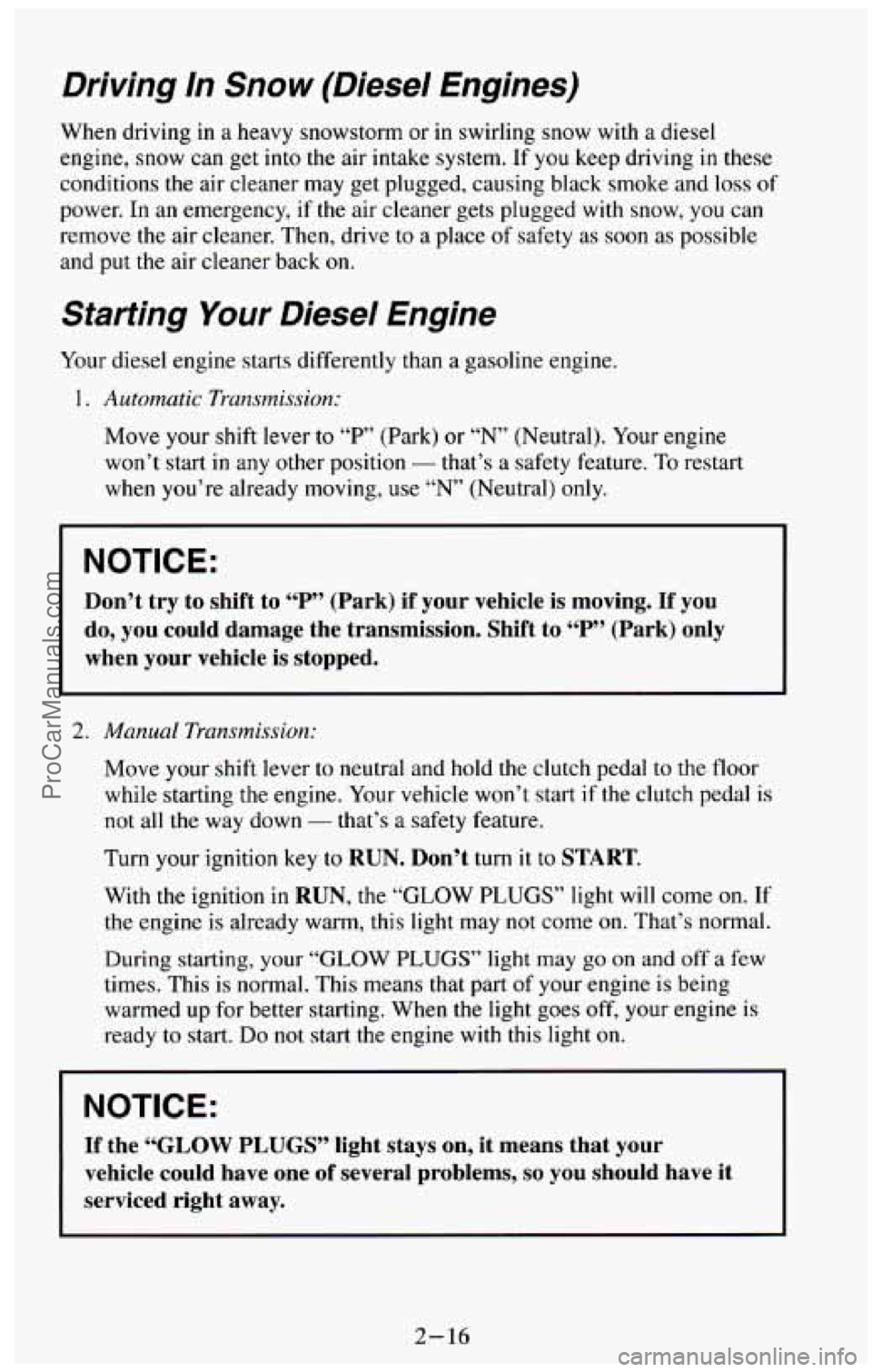
Driving In Snow (Diesel Engines)
When driving in a heavy snowstorm or in swirling snow with a diesel
engine, snow can get into
the air intake system. If you keep driving in these
conditions the air cleaner may get plugged, causing black smoke and loss of
power. In an emergency, if the air cleaner gets plugged with snow, you can
remove the air cleaner.
Then, drive to a place of safety as soon as possible
and put the air cleaner back
on.
Starting Your Diesel Engine
Your diesel engine starts differently than a gasoline engine.
1. Automatic Transmission:
Move your shift lever to “P’ (Park) or “N” (Neutral). Your engine
won’t start in any other position
- that’s a safety feature. To restart
when you’re already moving, use
“N” (Neutral) only.
NOTICE:
Don’t try to shift to 4‘P’’ (Park) if your vehicle is moving. If you
do, you could damage the transmission. Shift to
“P” (Park) only
when your vehicle is stopped.
2. Manual Transmission:
Move your shift lever to neutral and hold the clutch pedal to the floor
while starting
the engine. Your vehicle won’t start if the clutch pedal is
not all the way down - that’s a safety feature.
Turn your ignition
key to RUN. Don’t turn it to START.
With the ignition in RUN, the “GLOW PLUGS” light will come on. If
the engine is already warm, this light may
not come on. That’s normal.
During starting, your “GLOW
PLUGS” light may go on and off a few
times. This
is normal. This means that part of your engine is being
warmed up for better starting. When the light goes off, your engine is
ready to start.
Do not start the engine with this light on.
NOTICE:
If the “GLOW PLUGS” light stays on, it means that your
vehicle could have one
of several problems, so you should have it
serviced right away.
2-16
ProCarManuals.com
Page 79 of 385
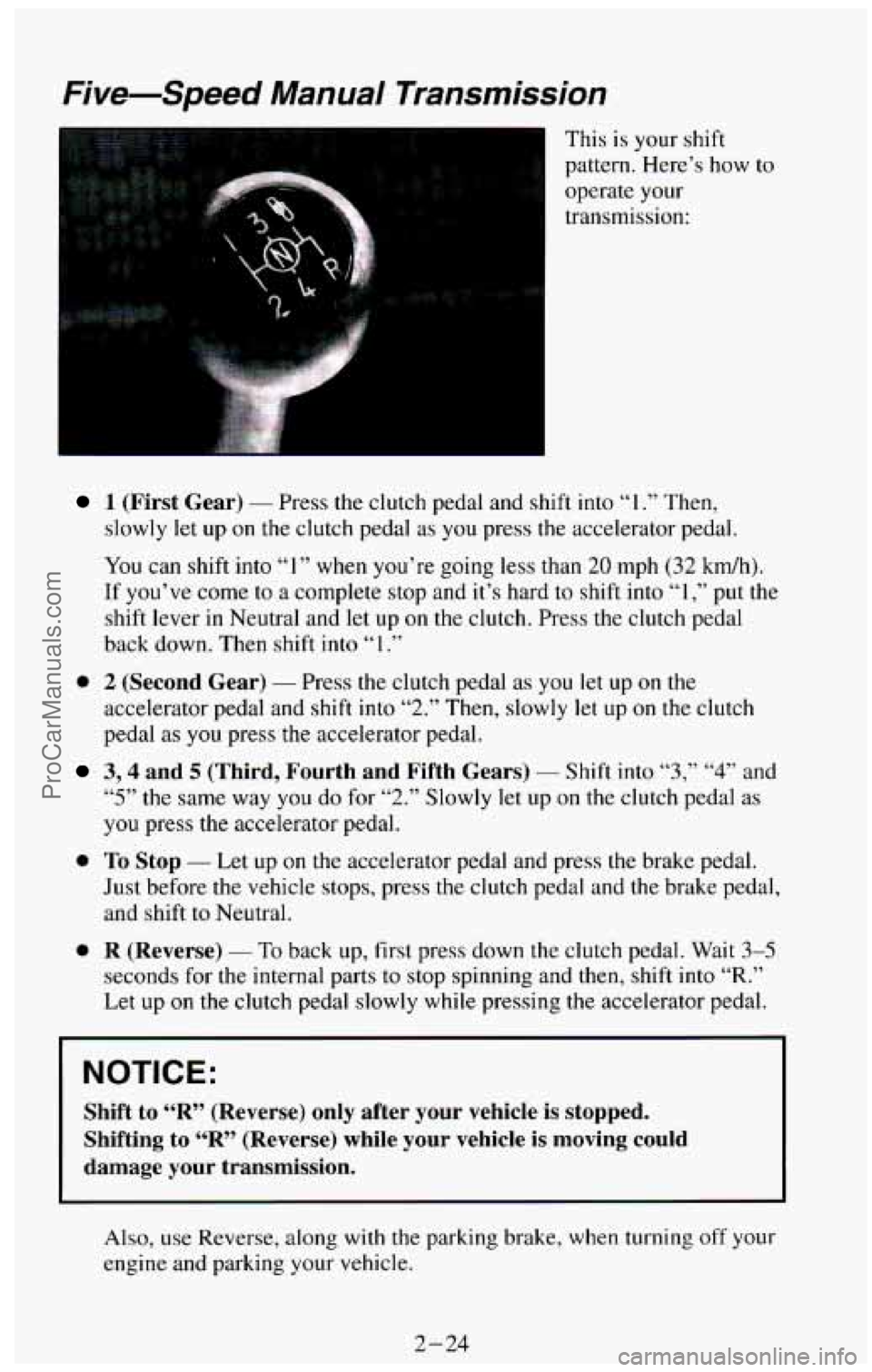
Five-Speed Manual Transmission
This is your shift
pattern. Here’s how
to
operate your
transmission:
..
1 (First Gear) - Press the clutch pedal and shift into “I .” Then,
slowly let up
on the clutch pedal as you press the accelerator pedal.
You can shift into
“1” when you’re going less than 20 mph (32 kdh).
If you’ve come to
a complete stop and it’s hard to shift into “1 ,” put the
shift lever
in Neutral and let up on the clutch. Press the clutch pedal
back down. Then shift
into “1 .”
0 2 (Second Gear) - Press the clutch pedal as you let up on the
accelerator pedal and
shift into “2.” Then, slowly let up on the clutch
pedal as you press the accelerator pedal.
3,4 and 5 (Third, Fourth and Fifth Gears) - Shift into “3,” “4” and
“5” the same way you do for “2.” Slowly let up on the clutch pedal as
you press the accelerator pedal.
Just before the vehicle stops, press the clutch pedal and the brake pedal,
0 To Stop - Let up on the accelerator pedal and press the brake pedal.
and shift to Neutral.
0 R (Reverse) - To back up, first press down the clutch pedal. Wait 3-5
seconds for the internal parts to stop spinning and then, shift into “R.”
Let up on the clutch pedal slowly while pressing the accelerator pedal.
NOTICE:
Shift to “R” (Reverse) only after your vehicle is stopped.
Shifting to
“R” (Reverse) while your vehicle is moving could
damage your transmission.
Also, use Reverse, along with the parking brake, when turning off your
engine and parking your vehicle.
2-24
ProCarManuals.com
Page 81 of 385
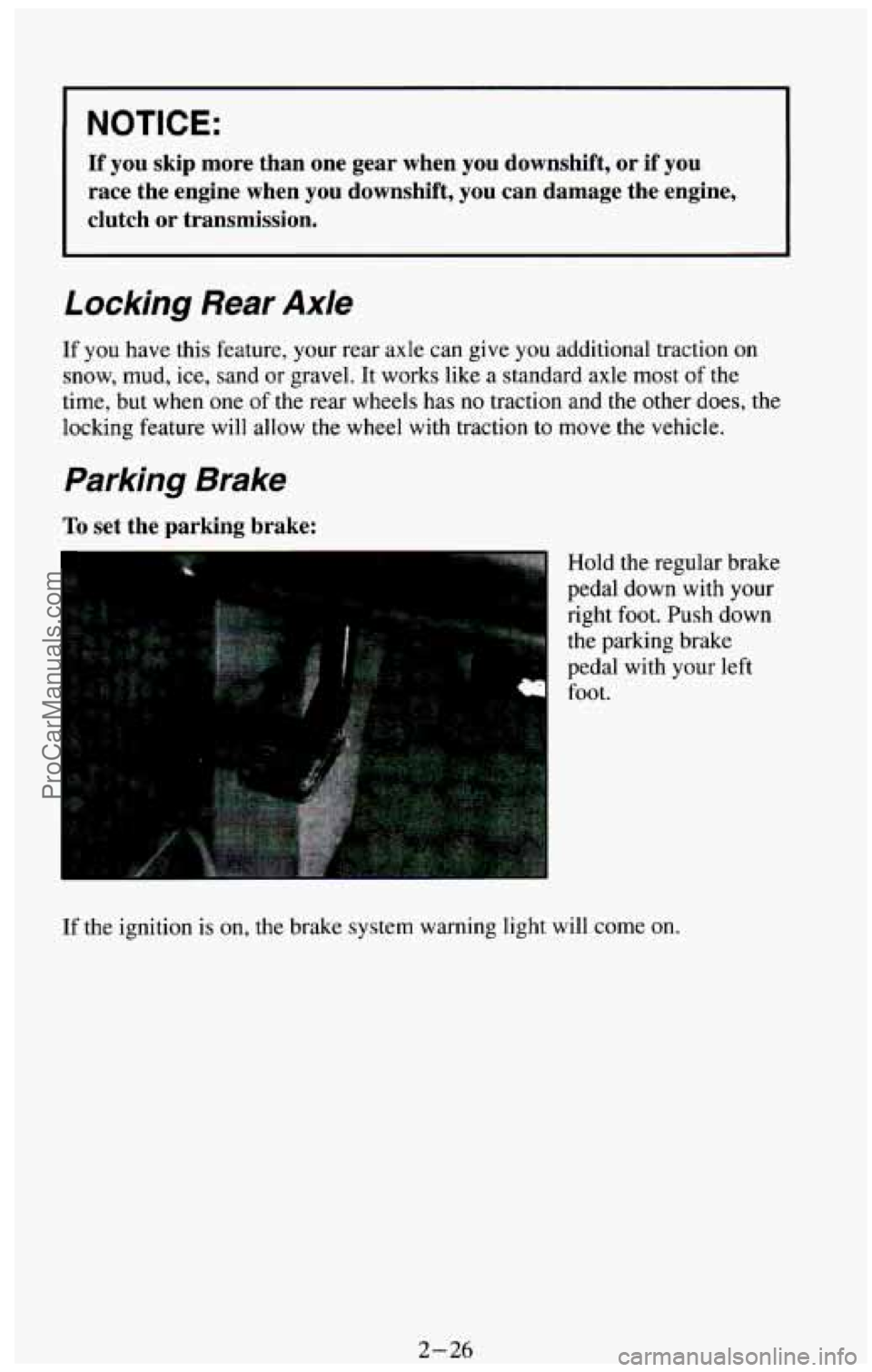
I NOTICE:
If you skip more than one gear when you downshift, or if you
race the engine when you downshift, you can damage the engine,\
clutch
or transmission.
Locking Rear Axle
If you have this feature, your rear axle can give you additional traction on
snow, mud, ice, sand or gravel. It works like a standard axle most of the
time, but when one
of the rear wheels has no traction and the other does, the
locking feature will allow the wheel with traction to move the vehicle.
Parking Brake
To set the parking brake:
Hold the regular brake
pedal down with your
right foot. Push down
the parking brake
pedal with
your left
foot.
If the ignition is on, the brake system warning light will come on.
2-26 ProCarManuals.com
Page 101 of 385
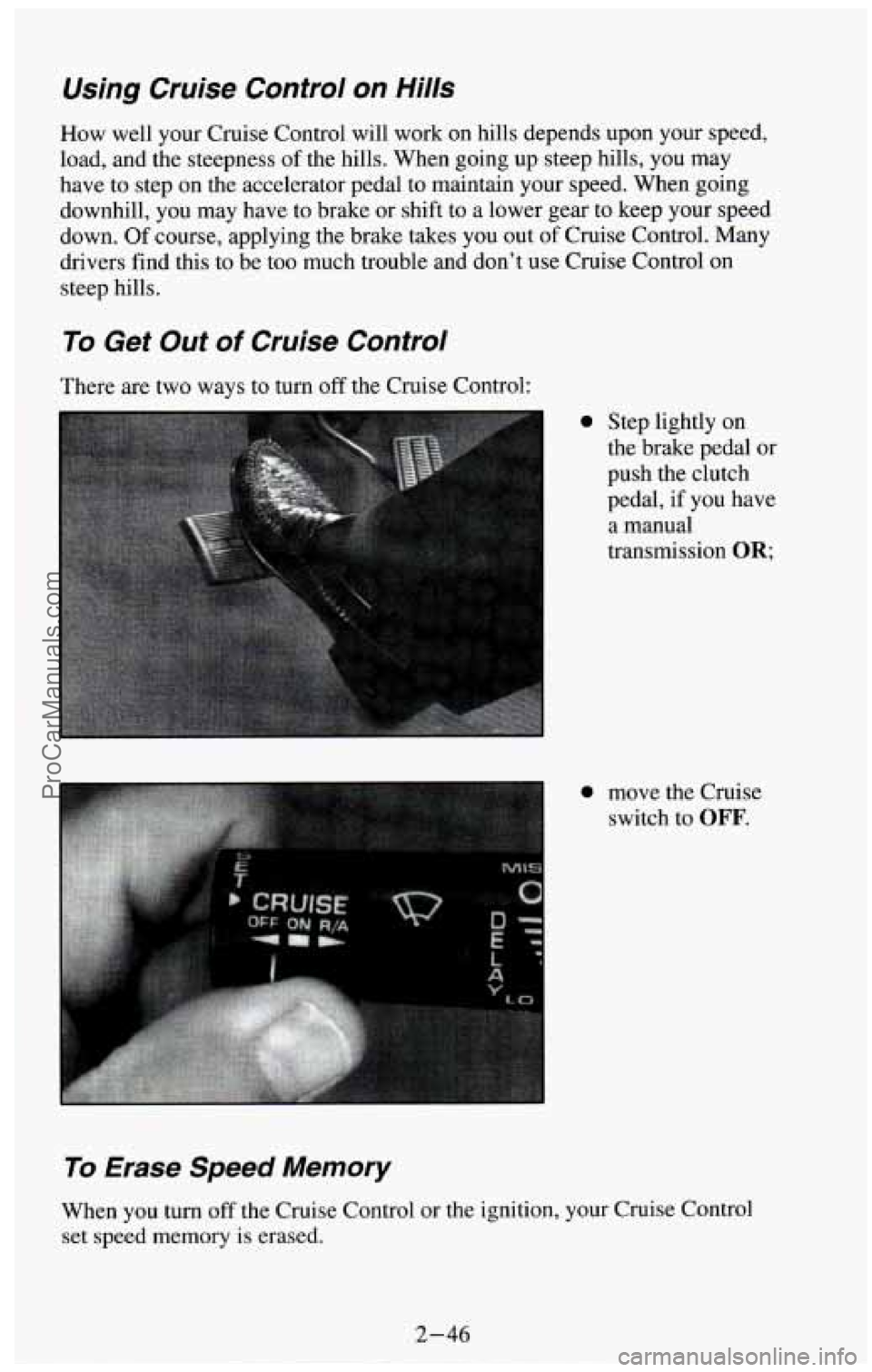
Using Cruise Control on Hills
How well your Cruise Control will work on hills depends upon your speed,
load, and the steepness of the hills. When going up steep hills, you may
have to step on the accelerator pedal to maintain your speed. When going
downhill, you may have to brake or shift to a lower gear to keep your speed
down. Of course, applying the brake takes you out
of Cruise Control. Many
drivers find this to be too much trouble and don't use Cruise Control on
steep hills.
To Get Out of Cruise Control
There are two ways to turn off the Cruise Control:
0 Step lightly on
the brake pedal or
push the clutch
pedal, if you have
a manual
transmission
OR;
0 move the Cruise switch to
OFF.
To Erase 5peed Memory
When you turn off the Cruise Control or the ignition, your Cruise Control
set speed memory
is erased.
2-46
ProCarManuals.com
Page 176 of 385
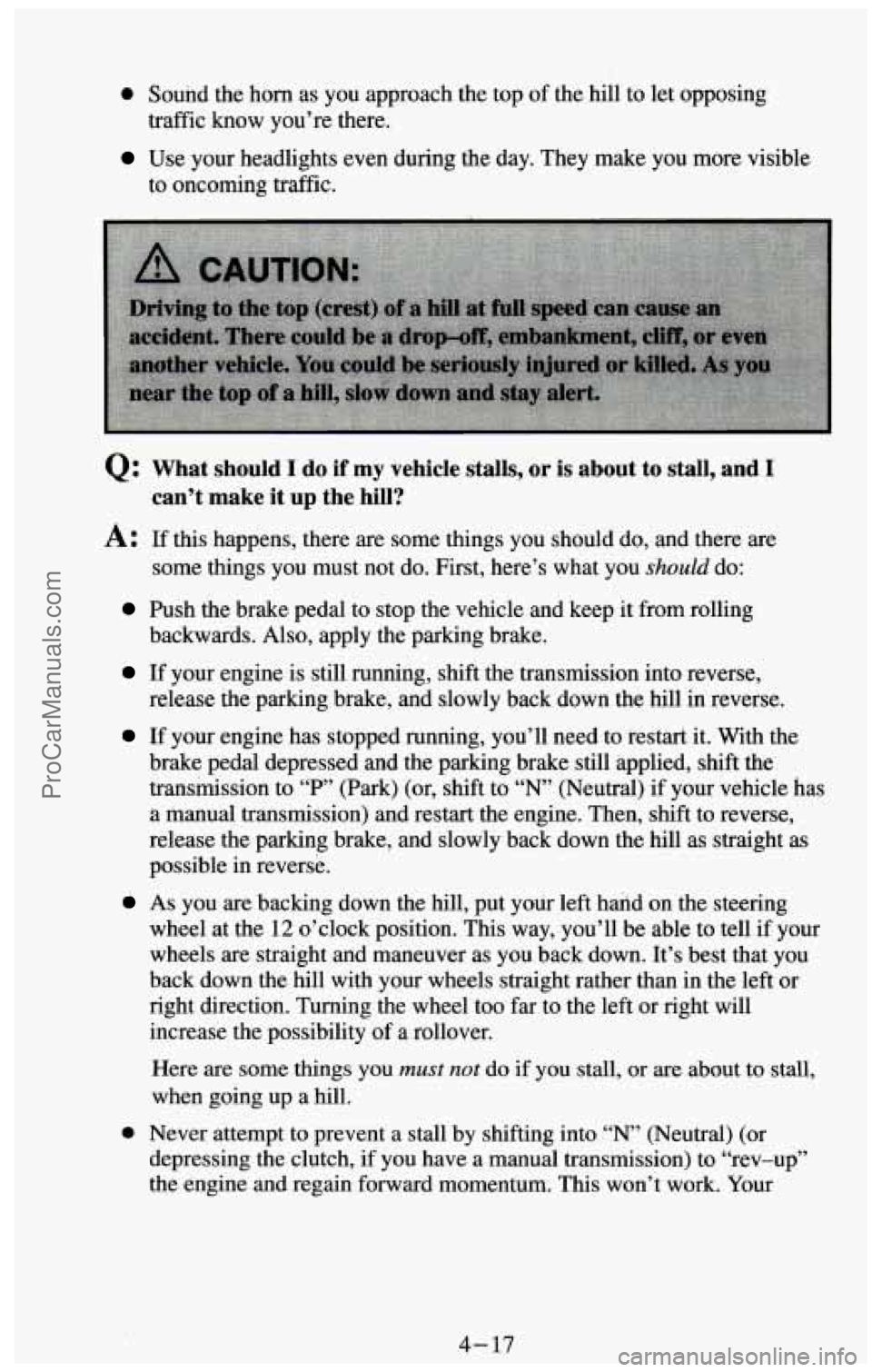
0 Sound the horn as you approach the top of the hill to let opposing
Use your headlights even during the day. They make you more visible
traffic know you’re there.
to
oncoming traffic.
Q: What should I do if my vehicle stalls, or is about to stall, and I
can’t make it up the hill?
A: If this happens, there are some things you should do, and there are
some things you must not do. First, here’s what you
should do:
Push the brake pedal to stop the vehicle and keep it from rolling
backwards. Also, apply the parking brake.
If your engine is still running, shift the transmission into reverse,
release the parking brake, and slowly back down the hill in reverse.
If your engine has stopped running, you’ll need to restart it. With the
brake pedal depressed and the parking brake still applied, shift the
transmission to
“P” (Park) (or, shift to “N’ (Neutral) if your vehicle has
a manual transmission) and restart the engine. Then, shift to reverse,
release the parking brake, and slowly back down the
hill as straight as
possible in reverse.
wheel at the
12 o’clock position. This way, you’ll be able to tell if your
wheels are straight and maneuver as you back down. It’s best that you
back down the hill with your wheels straight rather than in the left or
right direction. Turning the wheel too far to the left or right will
increase the possibility of a rollover.
As you are backing down the hill, put your left hand on the steering
Here are some things you
must not do if you stall, or are about to stall,
when going
up a hill.
0 Never attempt to prevent a stall by shifting into “N” (Neutral) (or
depressing the clutch, if you have a manual transmission) to “rev-up”
the engine and regain forward momentum. This won’t work.
Your
4- 17
ProCarManuals.com
Page 178 of 385
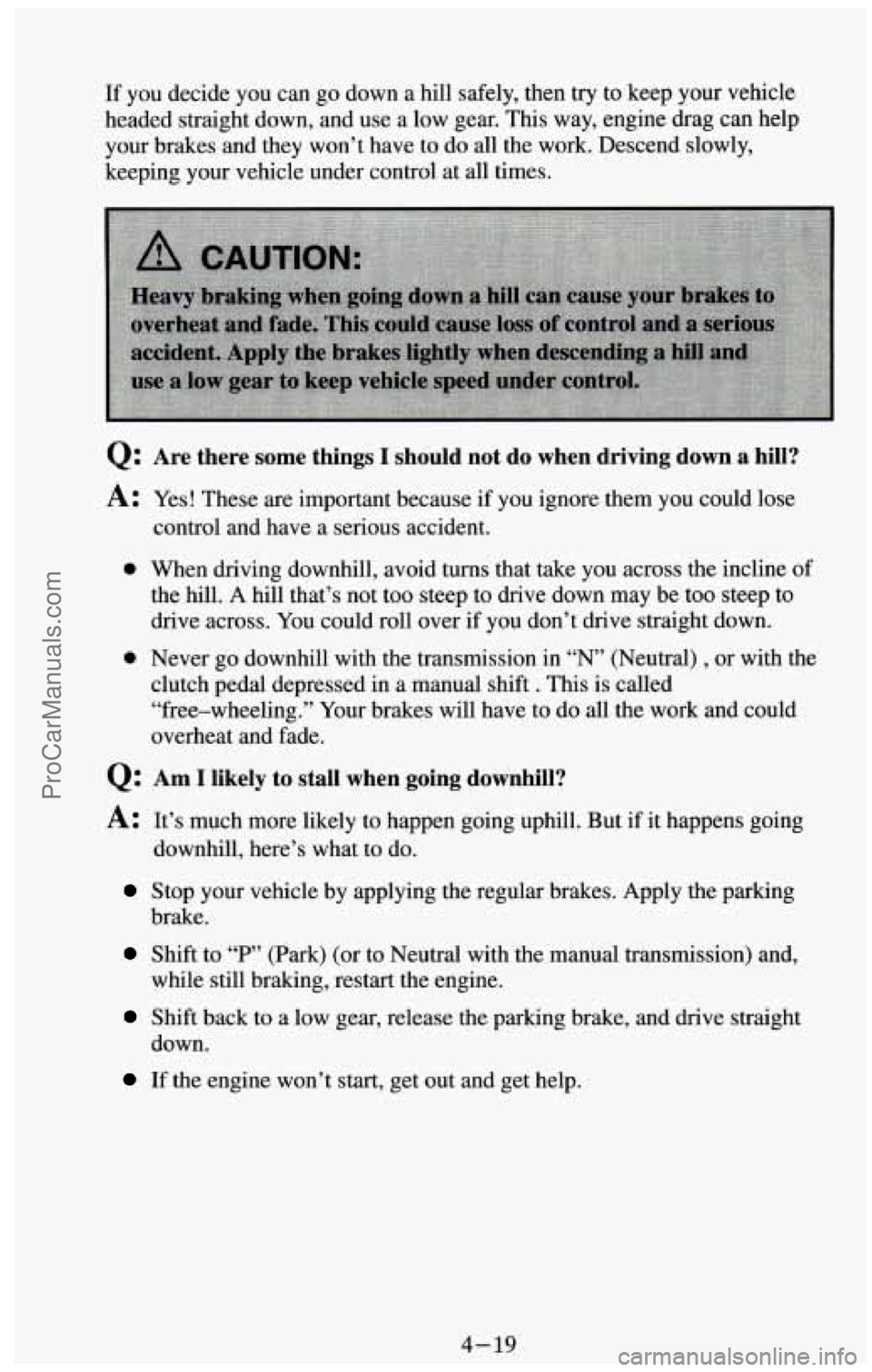
If you decide you can go down a hill safely, then try to keep your vehicle
headed straight down, and use a low gear. This way, engine drag can help
your brakes and they won’t have to do all the work. Descend slowly,
keeping your vehicle under control at all times.
Q: Are there some things I should not do when driving down a hill?
A: Yes! These are important because if you ignore them you could lose
control and have a serious accident.
0 When driving downhill, avoid turns that take you across the incline of
the hill. A hill that’s not too steep to drive down may be too steep to
drive across. You could roll over if you don’t drive straight down.
0 Never go downhill with the transmission in “N’ (Neutral) , or with the
clutch pedal depressed in a manual shift
. This is called
“free-wheeling.” Your brakes will have to do all the work and could
overheat and fade.
Q: Am 1 likely to stall when going downhill?
A: It’s much more likely to happen going uphill. But if it happens going
downhill, here’s what to do.
Stop your vehicle by applying the regular brakes. Apply the parking
brake.
Shift to “P,’ (Park) (or to Neutral with the manual transmission) and,
while still braking, restart the engine.
Shift back to a low gear, release the parking brake, and drive straight
down.
If the engine won’t start, get out and get help.
4- 19
ProCarManuals.com
Page 194 of 385
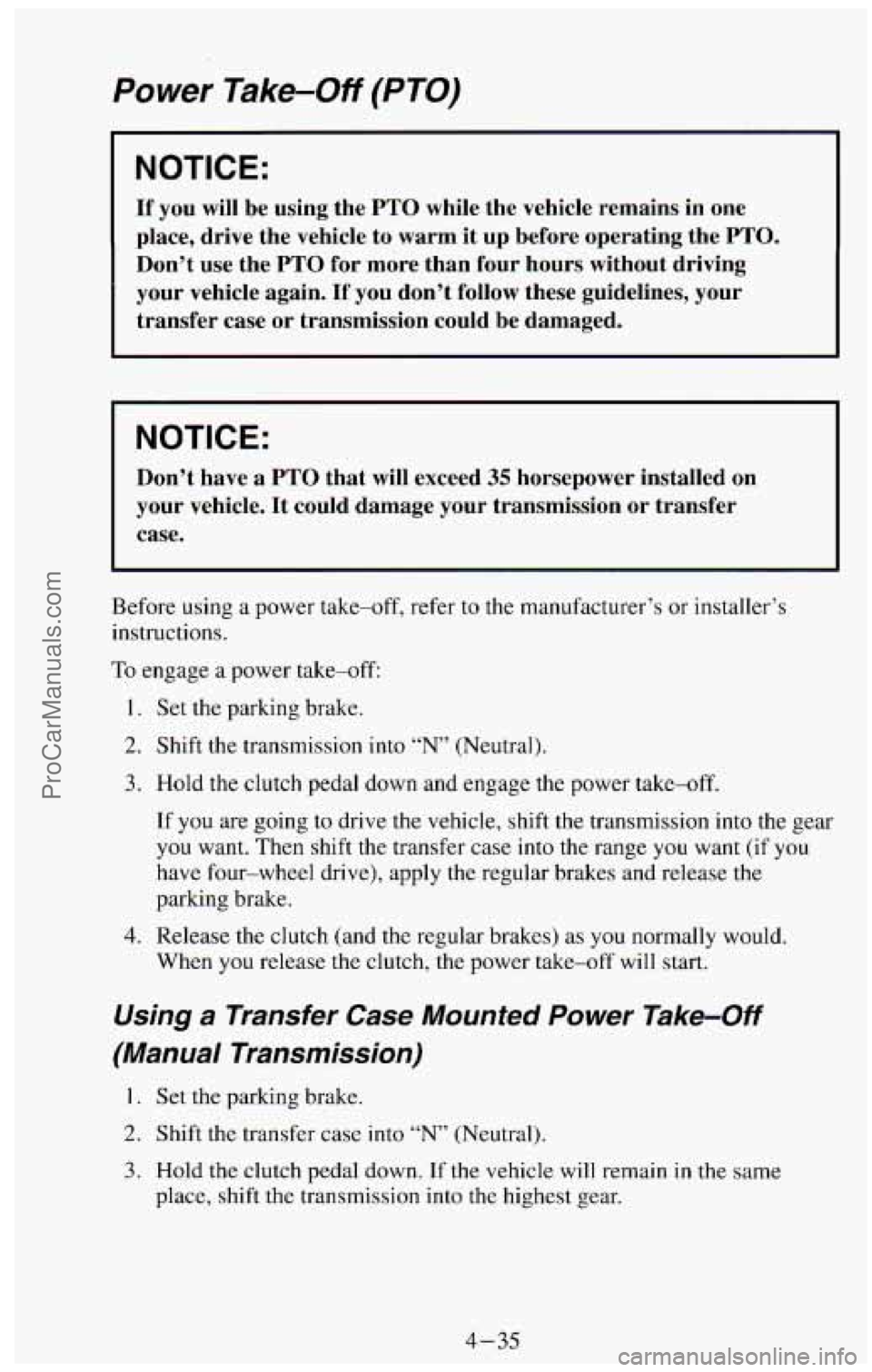
Power Take-Off (PTO)
NOTICE:
If you will be using the PTO while the vehicle remains in one
place, drive the vehicle to warm it up before operating the
PTO.
Don’t use the PTO for more than four hours without driving
your vehicle again. If you don’t follow these guidelines, your
transfer case or transmission could be damaged.
NOTICE:
Don’t have a PTO that will exceed 35 horsepower installed on
your vehicle. It could damage your transmission or transfer
case.
Before using a power take-off, refer to the manufacturer’s or installer’s
instructions.
To engage a power take-off:
1. Set the parking brake.
2. Shift the transmission into “N” (Neutral).
3. Hold the clutch pedal down and engage the power take-off.
If
you are going to drive the vehicle, shift the transmission into the gear
you want. Then shift the transfer case into the range you want (if you
have four-wheel drive), apply the regular brakes and release the
parking brake.
When
you release the clutch, the power take-off will start.
4. Release the clutch (and the regular brakes) as you normally would.
Using a Transfer Case Mounted Power Take-Off
(Manual Transmission)
I. Set the parking brake.
2. Shift the transfer case into “N” (Neutral).
3. Hold the clutch pedal down. If the vehicle will remain in the same
place, shift the transmission
into the highest gear.
4-35
ProCarManuals.com